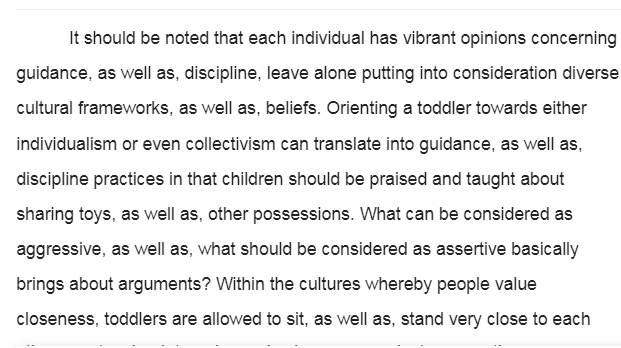Diversity in Early Care and Education
Requirements : APA format ,12 font double space,cover page , cites , references
Use MS Word to write your responses, and submit your answers to all three questions in one Word document.
Copy and paste each question within the document, so that your Instructor can see which question you are responding to.
In Chapter 7 of Diversity in Early Care and Education, Janet Gonzalez-Mena discusses the socialization, guidance, and discipline of young children. Imagine that you are a parent of a toddler and that you tend to orientate toward either individualism or collectivism. Describe one example of how that might translate into guidance and discipline practices, and explain why you think so.
Review the information on emotional expression and regulation presented on pages 132–133 of Diversity in Early Care and Education and pages 4–8 of How Culture Shapes Social-Emotional Development. Describe one or more reasons why families may or may not encourage emotional expression or regulation, and two or more ways in which the communication of emotions can vary. Then, explain how an infant/toddler professional could use this awareness to develop stronger relationships with families and provide responsive care to infants and toddlers.
“The Critical Importance of Cultural and Linguistic Continuity for Infants and Toddlers” (Chang & Pulido, 1994) presents some of the key issues related to cultural and linguistic diversity in infant and toddler care, including the absence of home language in many care giving environments. Based on the information in this article, describe one or more possible effects that the absence of home language within a care giving relationship may have on cultural continuity, family functioning, and/or an infant or toddler’s social, emotional, or cognitive development. Then, write a brief rationale explaining why further research on this topic is needed.
Required Resources
Course Text: Diversity in Early Care and Education
Chapter 6, “Differing Perspectives on Learning through Play”
Chapter 7, “Socialization, Guidance, and Discipline”
Course Text: How Culture Shapes Social-Emotional Development
Read pp. 4–11, “Experiencing, Expressing, and Regulating Emotions” (up to “Identity Development and Relating to Others”)
Article: Chang, H., & Pulido, D. (1994). The critical importance of cultural and linguistic continuity for infants and toddlers. In E. Fenichel (Ed.), Cross-cultural studies of child development: Implications for clinicians. Retrieved from http://www.eric.ed.gov
Reproduced with permission of Zero to Three in the format Scan via Copyright Clearance Center.
Read pp. 14–18 of the PDF
Answer Preview-Diversity in Early Care and Education

